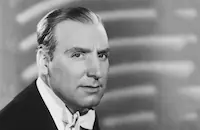Where Sinners Meet

Brief Synopsis
Cast & Crew
J. Walter Ruben
Diana Wynyard
Clive Brook
Billie Burke
Reginald Owen
Alan Mowbray
Film Details
Technical Specs

Synopsis
When Leonard and Ann's automobile breaks down on The Dover Road, an infamous English thoroughfare used by lovers who are escaping by boat to France, their chauffeur, Saunders, escorts them to the home of the mysterious Mr. Latimer, who claims they are in a hotel. After being compelled to spend the night, Leonard and Ann finally realize Saunders was paid to bring them there. Latimer, a rich bachelor, then explains that his hobby is forcing impassioned couples to spend a week together before embarking on the long road of marriage, in order to prevent unhappy alliances. Latimer also tells them that another couple, whose "probation" is up the next day, is staying at the house. The following morning, the other couple is revealed to be Leonard's wife Eustacia and her ill lover Nicholas. Eustacia's biggest complaint about Leonard is that he never became ill so she could take care of him, whereas Nicholas caught a bad cold the first day at Latimer's. When Ann comes down to breakfast, Latimer imitates Leonard so that she might practice her marital behavior, but she insists that Latimer bring their car around. Leonard then wakes with a nasty cold, and while Ann is unsympathetic, Eustacia enters and cossets him. While Leonard and Eustacia resume their marital roles, Nicholas and Ann become acquainted, but by the third day, when Ann asks Nicholas for money to get home, he realizes the affair is a lost cause. Both men admit they are fed up with women and plan to escape from England. Latimer, meanwhile, schemes to make one of his servants ill to draw Eustacia's attention away from Leonard, and he himself pretends to contract uralgia, drawing Ann's sympathies. Although Latimer expresses his love to Ann, she takes off in his car. Before she has gotten very far, however, she discovers that Latimer is in the car with her and is determined to take her to Dover.

Director
J. Walter Ruben
Cast

Diana Wynyard
Clive Brook

Billie Burke

Reginald Owen

Alan Mowbray

Gilbert Emery
Phyllis Barry
Walter Armitage
Katherine Williams
Robert Adair
Vernon Steele
Crew
David Abel
Pandro S. Berman
Perry Ferguson
H. W. Hanemann
Jack Hively
David Lewis
Ray Lissner
Nick Musuraca
Walter Plunkett
Van Nest Polglase
Max Steiner
Paul F. Wiser

Film Details
Technical Specs

Articles
Where Sinners Meet -
By Glenn Erickson

Where Sinners Meet -
Quotes
Trivia
Notes
The working title of this film was Dover Road. A March 1934 Daily Variety news item announced that the title had been changed from Dover Road to Where Lovers Meet, but it is possible that the latter title might have been an error. RKO borrowed Diana Wynyard from M-G-M for the production. Her name is spelled "Wynward" on one frame of the opening credits. In 1927, William de Mille directed Vera Reynolds in The Little Adventuress, a De Mille Pictures' version of A. A. Milne's play (see AFI Catalog of Feature Films, 1921-30; F2.3103).














